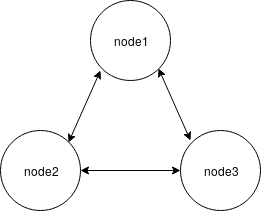c-lightning Docker Setup
The docker-compose images and the instructions in this repository are to setup a local Bitcoin network (regtest mode) and run a Lightning Network (c-lightning nodes) over it.
Setup
There is one docker-compose file for each node in our Lightning Network. Each docker-compose file has two services each, one that runs bitcoind and another that runs lightningd. We will need an instance of both for each node. We can connect all the c-lightning daemons to the same bitcoind instance, but for the sake of completeness we will set up an instance of bitcoind for each node.
The bitcoind containers will be named bitcoind1, bitcoind2 and so on, and the corresponding lightningd containers lightningd1, lightningd2 and so on. We will be opening multiple terminal windows to interact with the daemons via CLI. A single shell instance can also be used but I find it convenient to have separate shells open to each container.
We will be setting up a topology as follows:

You can create more nodes by duplicating the docker-compose files and set up a topology of your choice.
All the containers are connected via a LN_testing docker network. We first create the docker network:
docker network create 'LN_testing'Note that there may be a better way to do this, but I am new to docker and this was one way I found to go about this. If there is a more optimal way, feel free to raise a pull request.
Running the containers
Clone the repository onto your PC:
git clone https://github.com/samvid25/c-lightning-docker.gitCreate the lightningd and bitcoind containers. Run this for all the docker-compose files in different terminal windows/tabs.
docker-compose -f "docker-compose-1.yml" upNow, our 4 lightning nodes are set-up. Open 2 terminals each for every node, one to interact with bitcoind and one for lightningd. Repeat the following for every node in different terminals:
docker exec -i -t bitcoind1 bashdocker exec -i -t lightnind1 bashWe will be using bitcoin-cli to interact with bitcoind and lightning-cli to interact with lightningd. Aliases can be used to make your life easier as you will be using these commands a lot:
bitcoind1$ cat >> /home/.bashrc
alias bc='bitcoin-cli'
bitcoind1$ source /home/.bashrclightningd1$ cat >> /home/.bashrc
alias lc='lightning-cli'
lightningd1$ source /home/.bashrcRepeat the same for all containers.
But using bitcoin-cli runs into a rpcuser error where it says credentials are not found. We will have to manually edit the bitcoin.conf file present at /root/.bitcoin/:
bitcoind1$ cat > /root/.bitcoin/bitcoin.conf
printtoconsole=1
rpcallowip=::/0
regtest=1
whitelist=0.0.0.0/0
server=1
rpcuser=rpcuser
rpcpassword=rpcpassTo ensure that all the nodes have a copy of the same blockchain, establish connections within themselves by appending a addnode=bitcoind1 to the config file for the subsequent bitcoind instances. (addnode=bitcoind2 can also be added to bitcoind3 and so on)
I believe this can also be done via the docker-compose file without having to manually doing it after container deployment. Will update the docker-compose files with the same soon.
The following sections assume you run the commands in their appropriate terminals (bitcoin-cli in the bitcoind terminals and the lightning-cli in the lightningd terminals) for the required nodes.
Generate a few blocks on one of the nodes and see if the other nodes detect the blocks. If so, then the containers have been set up correctly.
bitcoind1$ bc generate 5Creating connections
Obtain the ID of all the lightning nodes using:
lightningd1$ lc getinfo | grep id
lightningd2$ lc getinfo | grep id
lightningd3$ lc getinfo | grep idThen connect the nodes to each other:
lightningd1$ lc connect <id2>@lightningd2
lightningd1$ lc connect <id3>@lightningd3
lightningd2$ lc connect <id3>@lightningd3Now, we need a payment address to fund the node. Run the following on all the nodes and note the generated address for each node:
lightningd1$ lc newaddr
lightningd2$ lc newaddr
lightningd3$ lc newaddrNow, we need to fund these nodes. Generate a few blocks so that some bitcoin is created. And then send funds (as required) to the addresses:
bitcoind1$ bc generate 200
bitcoind1$ bc sendtoaddress <address1> 200
bitcoind1$ bc sendtoaddress <address2> 200
bitcoind1$ bc sendtoaddress <address3> 200
bitcoind1$ bc generate 10A few blocks are generated at the end to confirm the above transactions.
Use the following command to check if funds have been received or not. Note that it may take time for the funds to be appear due to block synchronization delays.
lightningd1$ lc listfunds
lightningd2$ lc listfunds
lightningd3$ lc listfundsOpening channels
Once the nodes have enough funds to open a channel, channels can be opened with:
lightningd1$ lc fundchannel <id2> 150000
lightningd2$ lc fundchannel <id3> 150000
lightningd3$ lc fundchannel <id1> 150000But the the funding transaction for this channel is still unconfirmed. Hence, a few blocks have to be generated to confirm the funding transaction and change the state of the channel to CHANNELD_NORMAL and make its visibility public.
bitcoind1$ bc generate 10All the known (active) channels in the network can be listed using:
lightningd1$ lc listchannelsIn a larger network, the existance of a path to a node identified by can be checked using:
lc getroute <id> <msatoshi> <riskfactor>Optional: Changing lightningd configuration
Modify (or Add if it doesn't exist) the config file present at /root/.lightning/ with the required parameters and restart lightningd:
lightningd1$ lc stopdocker start lightningd1
docker exec -i -t lightningd1 bashin progress